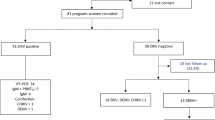Abstract
In countries such as the United States where rubella virus infections are rare, congenital rubella syndrome (CRS) may not be recognized in a timely manner. However, the syndrome still appears in this country, often in infants of mothers emigrating from countries with absent or suboptimal national vaccination programs. We describe a case of CRS in a term baby born to a recent US immigrant who developed a primary varicella infection in late pregnancy and demonstrated IgG titers to rubella at delivery. At presentation, the neonate had both classical findings as well as less reported vascular and neurological abnormalities seen in infants with CRS.
This is a preview of subscription content, access via your institution
Access options
Subscribe to this journal
Receive 12 print issues and online access
$259.00 per year
only $21.58 per issue
Buy this article
- Purchase on Springer Link
- Instant access to full article PDF
Prices may be subject to local taxes which are calculated during checkout


Similar content being viewed by others
References
Centers for Disease Control and Prevention. Elimination of rubella and congenital rubella syndrome - United States, 1969-2004. Morb Mortal Wkly Rep 2005; 54: 279–282.
Reef SE, Redd SB, Abernathy E, Zimmerman L, Icenogle JP . The epidemiological profile of rubella and congenital rubella syndrome in the United States, 1998-2004: the evidence for absence of endemic transmission. Clin Infect Dis 2006; 43: S126–S132.
Centers for Disease Control and Prevention. Three cases of congenital rubella syndrome in the postelimination era - Maryland, Alabama, and Illinois, 2012. Morb Mortal Wkly Rep 2013; 62: 226–229.
Caidi H, Abernathy ES, Benjouad A, Smit S, Bwogi J, Nanyunja M et al. Phylogenetic analysis of rubella viruses found in Morocco, Uganda, Cote d’Ivoire, and South Africa from 2001 to 2007. J Clin Virol 2008; 42: 86–90.
Gregg N . Congenital cataract following German measles in the mother. Trans Ophthalmol Soc Aust 1941; 3: 35–46.
Givens KT, Lee DA, Jones T, Ilstrup DM . Congenital rubella syndrome: ophthalmic manifestations and associated systemic disorders. Br J Ophthalmol 1993; 77: 358–363.
Wolff SM . The ocular manifestations of congenital rubella. Trans Am Ophthalmol Soc 1972; 70: 577–614.
American Academy of Pediatrics. Rubella In: Pickering LK, Baker CJ, Kimberlin DW, Long SS (eds). Red Book: 2012 Report of the Committee on Infectious Diseases 29th ed Elk Grove Village, IL: American Academy of Pediatrics, 2012 p 629–634.
Desmond MM, Wilson GS, Vorderman AL, Murphy MA, Thurber S, Fisher ES et al. The health and educational status of adolescents with congenital rubella syndrome. Dev Med Child Neurol 1985; 27: 721–729.
Ishikawa A, Murayama T, Sakuma N, Takase A, Shishido T, Nagamatsu K et al. Computed cranial tomography in congenital rubella syndrome. Arch Neurol 1982; 39: 420–421.
Bale J . Fetal infections and brain development. Clin Perinatol 2009; 36: 639–653.
Lanari M, Capretti MG, Lazzarotto T . Neuroimaging examination of newborns in vertically acquired infections. J Matern Fetal Neonatal Med 2011; 24: 117–119.
Beltinger C, Saule H . Sonography of subependymal cysts in congenital rubella syndrome. Eur J Pediatr 1988; 148: 206–207.
Hua M, Odibo A, Macones G, Roehl K, Crane J, Cahill A . Single umbilical artery and its associated findings. Obstet Gynecol 2010; 115: 930–934.
Naeve RL, Blanc W . Pathogenesis of congenital rubella. JAMA 1965; 194: 1277–1283.
Moore CM . Single umbilical artery and congenital rubella. J Pediatr 1969; 75: 157–158.
Webster W . Teratogen update: congenital rubella. Teratology 1998; 58: 13–23.
Berger BE, Omer SB . Could the United States experience rubella outbreaks as a result of vaccine refusal and disease importation? Hum Vaccin 2010; 6: 1016–1020.
Goodson JL, Masresha B, Dosseh A, Byabamazima C, Nshimirimana D, Cochi S et al. Rubella epidemiology in Africa in the prevaccine era, 2002–2009. J Infect Dis 2011; 204: S215–S225.
Centers for Disease Control and Prevention. Progress toward control of rubella and prevention of congenital rubella syndrome - worldwide, 2009. Morb Mortal Wkly Rep 2010; 59: 1307–1310.
Author information
Authors and Affiliations
Corresponding author
Ethics declarations
Competing interests
The authors declare no conflict of interest.
Additional information
Supplementary Information accompanies the paper on the Journal of Perinatology website
Supplementary information
Rights and permissions
About this article
Cite this article
Fang, J., Agrawal, A., Gowtham, S. et al. Case Report: Congenital rubella syndrome: a rare but persistent concern in the United States. J Perinatol 33, 899–902 (2013). https://doi.org/10.1038/jp.2013.73
Received:
Revised:
Accepted:
Published:
Issue Date:
DOI: https://doi.org/10.1038/jp.2013.73


